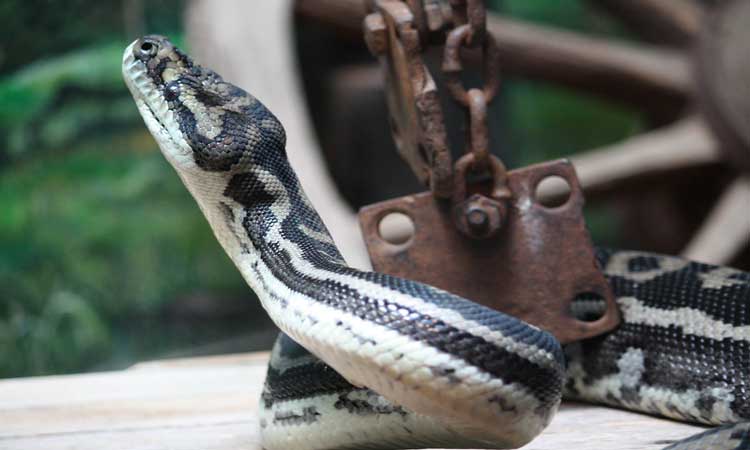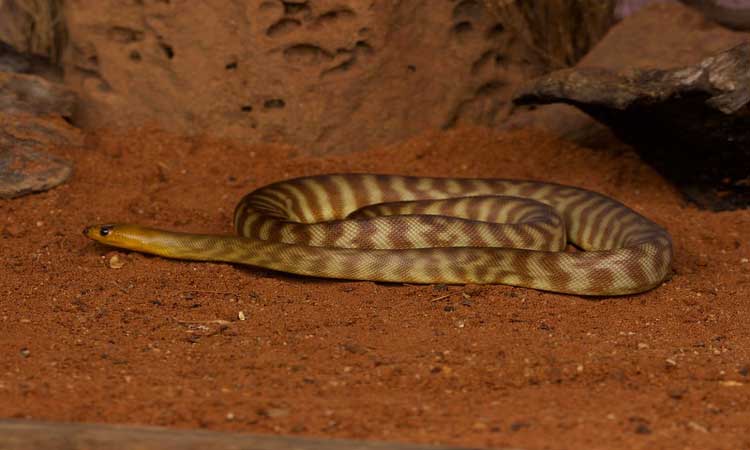Pythons are found originally in sub-Saharan Africa, Nepal, Bangladesh, India, Sri Lanka, and regions of Southeast Asia. In the USA they are found in small populations who have entered into the Everglades National Park since the 1990s.
They are good ambush predators and remain motionless when attacking prey.
Attack on humans has been a rare case. Pythons are a family of non-venomous snakes and one of the largest snakes of all species in the world.
From the wide variety of the species of python it is difficult to choose the best pet pythons. Go through this article, it may help you to deside which python is best pet snake for you.
Python Species Profile
Species- The Pythonidae, commonly known as pythons have ten genera and around 42 species recognized currently. Although this snake has been considered to belong to the boa family due to its resemblance, pythons are more closely related to sunbeam snakes (Xenopeltis) and burrowing pythons (Loxocemaus).
Kingdom: Animalia
Phylum: Chordata
Class: Reptilia
Order: Squamata
Suborder: Serpentes
Superfamily: Pythonoidea
Family: Pythonidae
Habitat
Pythons are available among rainforests, grasslands, savannas, swamps, rocky places, desert sandhills, and shrublands. They often seek shelter in trees, hollows, and rocky outcrops. The exception ones like the woman and the black-headed python can make their own homes by digging with their heads and curving necks.
Behavior
Pythons are good at ambushing their prey by using smell and sight. They have a special sensory organ that senses the heat of any nearby prey. They also use camouflaged motionless positions to hunt their food. They are not a threat to humans unless it feels threatened.
Conservation
Due to hunting a lot of species of pythons have disappeared such as the Indian Python, Python molurus. This snake is known for its beautifully patterned skin Also in Bangladesh and parts of Asia, the Burmese python has been decreasing in numbers. Its origin and natural history are lost. Pythons are killed for folk medicines in Asia and food purposes also in some places.
Feeding
The pythons feed on animals such as house cats or even adult deer. Some kinds of pythons even feed on antelopes. They tend to swallow their food or preys whole and take several days or even weeks to digest them completely. The technique with which the python attacks its prey and swallows is impressive. They use their teeth to grasp the pry first and then cause death by constriction and suffocation. Ultimately it causes cardiac arrest and death.
5 Best Pet Pythons
In order to learn which pythons are best for keeping as pets is an important process and you need to give some time to it. All pythons have many similarities in their nature and characteristics but they do have variations in size, weight, colors, and living styles. But the overall behaviors are the same. Let’s look at each of them one by one: –
1. Ball Pythons

Ball pythons are the most recommended snakes for pets as they are known to be the most gentle, non-aggressive snakes of all. They are up to 4 feet long in size and relatively smaller than the other pythons. Ball pythons can live up to 20 to 30 years when kept captive. They are also quite manageable and less expensive to maintain. Ball pythons are the best pets and harmless to humans with the right housing, food, and medical care.
2. Burmese Python

The next best choice for a pet python is the Burmese python that is available in pet stores and a good option for pet owners who want longer snakes. These snakes are 18 feet long and weigh around 200 pounds. So, it may be a slight hassle when handling them. But they have a good temperament and behave well especially if they are nurtured well from a younger age. They are excellent pets and those are experienced owners this is a good pet for them.
3. Children’s Python
The Children’s python is another non-venomous species that was named after John George Children, its founder. It grows up to 3 feet in length and is mostly found buried in the ground or climbing trees. This snake feeds on small mammals and birds. The children python attacks its prey by snatching them in mid-air and constricting them before swallowing it whole. As pets, the children’s python needs low maintenance as their sizes are not that long and need a medium-sized enclosure. This snake lives up to 30 years if kept captive as a pet at home.
4. Carpet Python

Carpet pythons are quite popular pets because of their different bright colors and also their calm nature and temperament. They are usually small in size but may vary according to their subspecies. The carpet python was originally found in North or South Australia and sometimes in Papua New Guinea. These snakes like to climb trees in order to catch their prey. They feed on rats, possums, birds, and lizards commonly. There are seven kinds of subspecies of the carpet python that belong to different habitats and environments such as jungles, coastal, inland, and so on.
5. Woma Python

The woma python has a unique personality and is one of the beautiful species and more active compared to all the other pythons. Because of its docile nature, it is easier for handling too as a beginner. This snake comes from the Central and Southwestern parts of Australia. As this snake loves dry and arid places to live it is mostly buried under the ground. The adult woma python can grow up to 12 feet in length and lives up to 20 years or more.
Having mentioned these most demanded pets there may be some biases of pet owners towards other kinds if they have the experience it’s well enough to go ahead. But for beginners, it would be suggested to choose the most well-behaved and compatible species and it is best to bring home a young or newborn pet python and breed from its earlier stage. Just like any other pet, it is a much better option to breed at the youngest age possible. As it grows and adjusts to the owner’s presence and care it is bound to be submissive and easier to keep longer.
Friendly Pythons VS Unfriendly Pythons
The term unfriendly here refers to snakes that are hard to make a pet or take some time to adjust to their new environment or enclosure. There are many kinds of snake species that are unpredictable in their behavior and might be prone to biting or quickly escaping.
In this case, we need to consider they are feeling safe and their needs are fulfilled completely. They have to feel less threatened as a whole with their new surroundings and enclosure.
On the other hand, the ball python is relatively friendlier and laid-back. It has low maintenance and does not have the tendency to bite unless it is attacked.
They do need a proper setup for their enclosure with the right heating.
Ball pythons are considered to be the friendliest and most docile pets. They are considered exotic also. They do often show a little aggressive behavior but it all depends on how provoked it can be.
But on the other hand, the ball pythons do not like cuddling or handling for too long. In contrast, the wild-caught ball python is not a good idea to keep as a pet or captive in your home. They are hard to feed in captives and they become defensive at times. The wild-caught ball pythons also have a chance of carrying more diseases and falling sick sooner or later.
The reticulated python is another kind that has a reputation for not adjusting to human captivity. These are relatively longer snakes up to 32 feet and are found in the habitats of Asia and the Philippines. They tend to kill farm animals during the night and can be capable of killing humans as well. Despite these factors, some hobbyists try to keep them as pets but at their own risks.
How To Choose The Best Pet Python For Your Homestead
In order to find the right kind of pet python for your home, there are these criteria needed to be followed by the new owners –
- Have the time and patience to care
- Know about the nature and characteristics of the python you want to pet
- Understand the science of their life and growth
- Learn about their needs and eating habits
- Learn about their entire behavior pattern
- Choose the most human-friendly and calm natured python
- Learn about all the risks and threats that might become a challenge
- Last but not least, it is best to start with the younger pet python and bred and born in captivity
Avoid choosing the pythons caught from the wild as they will have difficulty adapting to a new environment especially when kept captive. They could be prone to stress-related illnesses. They also might not eat properly which is hard to manage.
Tips For Being A Good Owner Of A Pet Python
There are several pet python owners in the world and in order to be good at it we need to note some valuable tips. Here are some essential tips you might need to consider when getting a pet python of your choice: –
- Get a perfect home or enclosure for the python considering its size and weight
- Provide the right feed and water availability
- Make regular medical check-ups
- Give the space needed to make sure it does not feel threatened
- Keep its home clean every day to avoid any pathogens or diseases to occur
- Sufficient heat, light, and humidity should be available
If you want to be a very good keeper then the best option is choosing a young or newborn python then you will have a greater experience as the snake grows bigger and from time to time understands its owner.
As long you follow the guidelines and proper care and nurturing it is certain you will have the best pet python.

